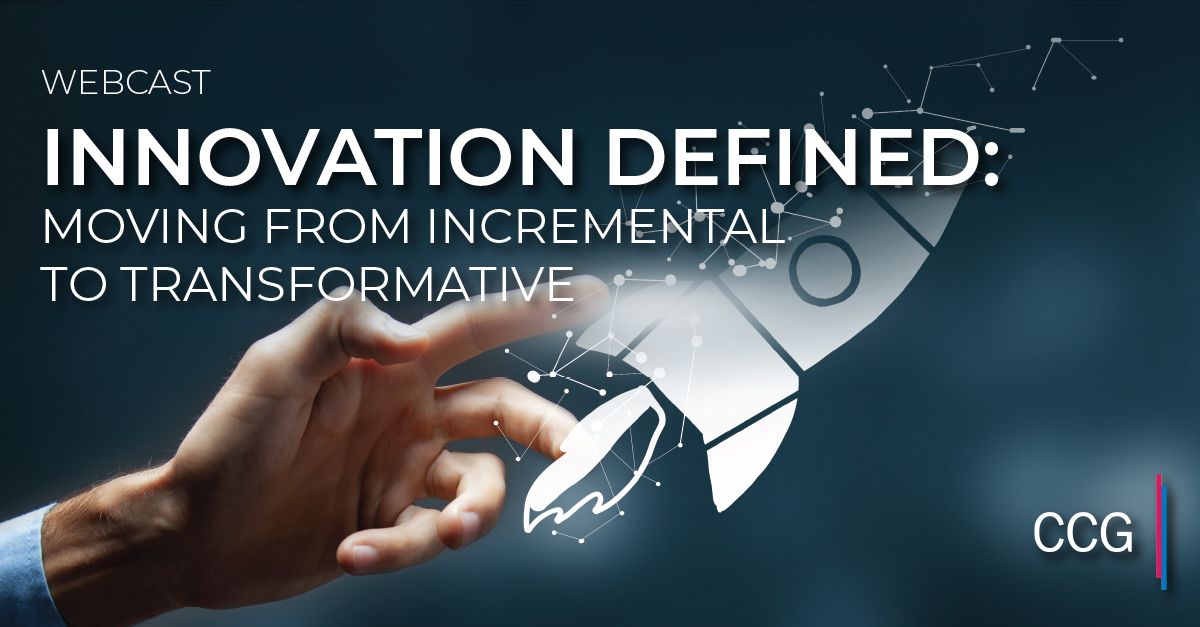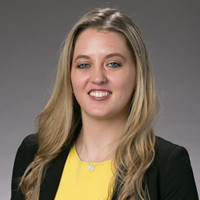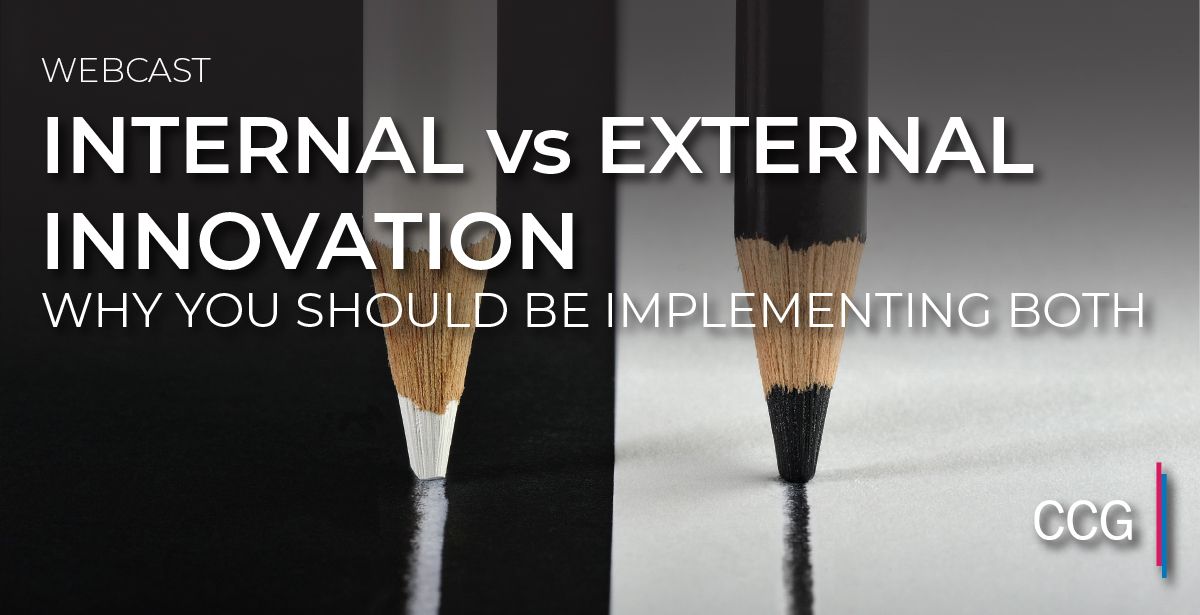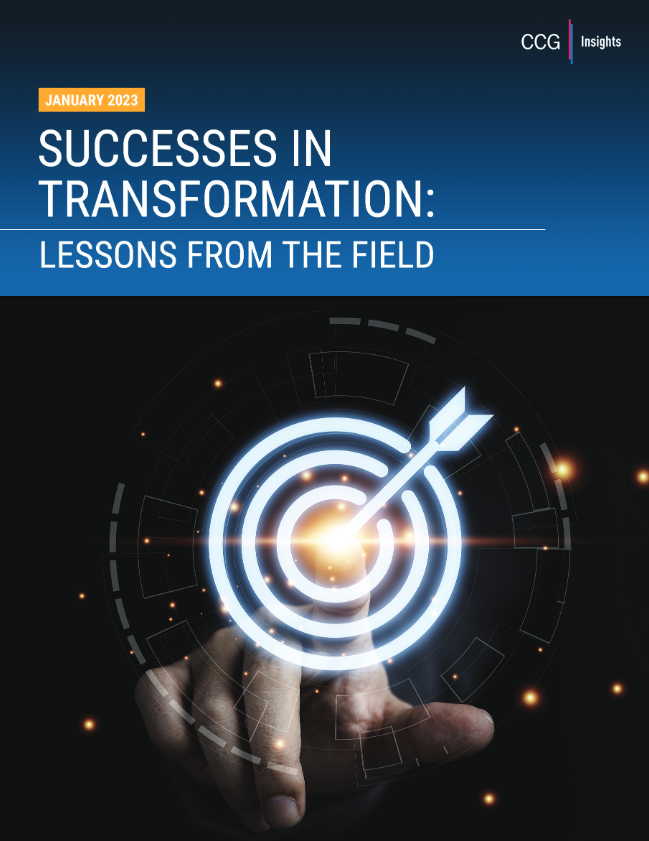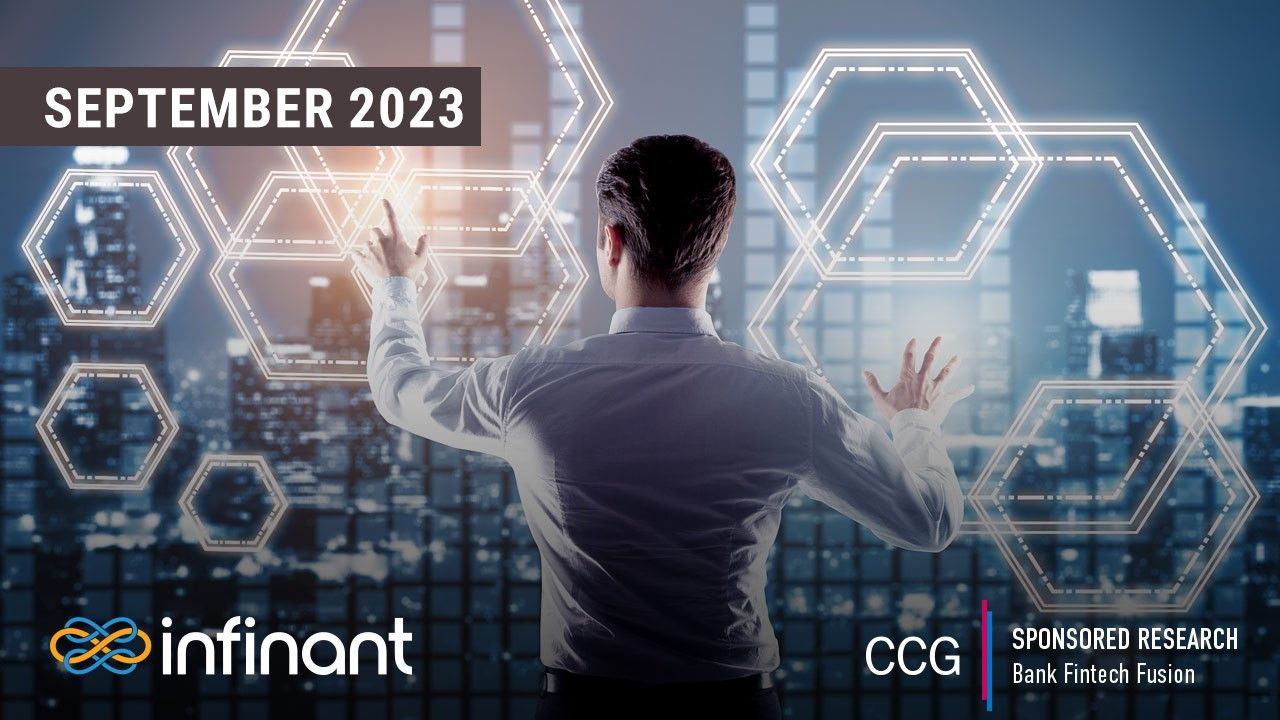Available On Demand – 18 minutes
To stay relevant and connected with customer needs, banks must continuously evolve through innovation. It is easy to get caught up in innovation theatre and not really move the needle. What does innovation mean for your financial institution and how can you build towards transformative, game changing innovation? Join the CCG team with host Emily Lockwood as she sits down with CCG’s Managing Director and Chief Strategy and Innovation Officer Scarlett Sieber to discover the difference between incremental and transformative innovation and how to start building towards the future today.
Subscribe to CCG Insights.
[restrict]
Emily Lockwood Hello, welcome to the CCG webcast. I’m Emily Lockwood, your host and Marketing Communications Consultant at CCG. I’m joined today by Scarlett Sieber, our Managing Director and Chief Strategy and Innovation Officer. Hi, Scarlett, thanks for joining us today.
Scarlett Sieber Hey, Emily, thanks for having me. Happy to be here and excited to be talking about part of my title, which is around innovation. So super, super stoked for that.
Emily Lockwood Awesome. OK. So today we’re going to be talking about incremental and transformative innovation and discuss a little bit about what goes into building strategy for banks. But before we get into that, I have a few housekeeping items to go over with you. If you look below Scarlett and I face’s, you will see our headshots. If you click on that, it will direct you to our bios as well as our LinkedIn, our Twitter accounts. You’ll also see the CCG logo next to our headshots. If you click on that, you’ll see all of our insights and blogs and all the latest updates on CCG. There’s also a Q&A icon. We really want you to click on that and ask us questions and we will try to get back to you during the live webcast. But if we don’t, we will be sure to answer you as soon as possible by the end of the day. And with that, I want to jump in Scarlett to our first question. So there are many ways to break down innovation. But let’s start with the basics of what many financial institutes will get started with. There’s often talk of incremental innovation versus transformative innovation. So can you define the difference between the two?
Scarlett Sieber Absolutely, so when. Typically when financial institutions, banks, credit unions, the like and by the way, this is applicable in many industries, not necessarily just ours. When people are talking about when corporates are talking about innovation. Usually they’re actually referring to incremental innovation and less so on the transformative. So incremental is really think of it in the most simplistic terms as small changes. A lot of if you’ve spent any time lucky, innovation principles are different things like different horizons. So this is really horizon one. This is the basic getting started, small changes, changes in formats, things like that. Kind of if you think about almost the evolution of a human and you start by crawling, then walking, then running. Incremental is definitely the crawling phase. And it’s where you can really see an impact quickly. So a simple example would be if you have, let’s say, 10 steps for your onboarding online mobile application process. If you had found a way to move that down to five or six steps, that could be considered incremental innovation. Transformative innovation, on the other hand, is big picture, big ideas, large changes back to the horizon scale. This is really horizon three. This usually takes multiple years to come to fruition. And that’s definitely not something that you’re going to see the impact of in the short term, or it would be very unlikely to see the impact of in the short term.
Emily Lockwood So thinking about, you know, the difference between incremental and transformative. Where do banks and credit unions typically focus their time on? Is it incremental or is it transformative?
Scarlett Sieber It’s definitely on the incremental. I would say, and there’s been a fair amount of studies from a variety of organizations that I’ve actually looked at this from banks as small as a thousand people or less to institutions much, much larger. And what they have found is that banks typically do focus on incremental. And this is more than 50 percent that I’ve seen. Financial institutions actually focus on that. With only 20 percent, or one in five, actually focusing on the transformative. There is, you know, so you do the math, 50 plus 20 so 30 left. So there’s about 30 that would probably fall somewhere in between. But a majority of institutions, including some of the larger ones who may have some nice press releases and things about doing some big innovation type things definitely tend to fall towards that 50 percent, doing just the incremental. But it is not surprising that typically the bigger the company, more resources, headcount, budget, you name it, they typically are the ones who will have a bit more activity on the transformational or transformative side.
Emily Lockwood So when banks and credit unions are building out their incremental innovation strategy or plan, what does that look like? What are the goals for that? And also, where does this group typically sit within the organization?
Scarlett Sieber It’s a great question. So for the incremental side, sorry, you can hear the lovely grass cutting outside. But for the incremental side, there are kind of a few goals. A lot of it, and this is basically where people tend to start with things like reducing redundancies, finding ways to, so that goes back to the example I gave you of 10 steps to get to your online application versus six. So maybe there’s pieces that you can kind of make smaller there. It’s really about operating more efficiently. So what can you do to enhance and improve those experiences. That could be both external for the consumers or internal for your own organization on how you’re gathering data or whatever else. You’re looking at things. Goals here, too, is about slight increases in revenue. So it’s adding this extra bell or whistle to whatever else it is that you’re having. So you’re not expecting this to be a game changer. That’s going to be a whole new business line, most likely, but little things to help impact the revenue. And you’re really typically the focus and goal is to serve your existing customers and your existing markets more efficiently than you have to that point. So for in terms of areas responsible, it typically falls within line of business because of that incremental- just which really just means to people who have specific roles, they can see areas of opportunity and ways to do things better, which leads to incremental innovation. So that would be within the line of business. That’s the most common. It doesn’t make a lot of sense if you’re focusing truly on incremental innovation to have a dedicated innovation unit or a dedicated unit and like a lab or something for this type of innovation. Unless they have a much bigger purview where maybe you’re doing an entire cultural overhaul and you’re really wanting to build out advocates at the company wide level and doing a lot of other things, maybe that makes sense. But otherwise, if you’re truly just doing incremental innovation and getting started, you don’t typically need additional resources and dedicated units around this.
Emily Lockwood So now let’s move over to the transformative innovation side of things. How are the goals different and where does the transformative innovation usually set within an organization?
Scarlett Sieber Well, the goals are very different. Transformative is in my personal opinion, it’s the fun part, but also the very frustrating part for a variety of reasons, which we’ll briefly touch on. And I’ve certainly spent time, by the way, in my career with financial institutions, big and small, looking at both of these. And so on the transformative side. There’s kind of the highest highs. But then also there’s a lot of disappointment and waiting and impatience. So what are the goals. The goals of transformative innovation really is a lot on R&D research and development, testing and learning. It’s when you’re thinking about potentially expanding into a new business line, when you’re thinking about testing something that you might have seen that’s interesting and new to the market, that’s usually a group where it would go to. So it’s really test and learn research. I personally feel that especially for our smaller financial institutions, limited resources make it challenging to do a lot of these things. But research is one area that’s not getting as much of a priority as it should, because people are making a lot of decisions based off of not all the facts. And research plays a huge role in that. So that’s one great opportunity for transformative innovation. The other goal would be around big wins. So when you are doing this well and you make the right bets, you can be leading the industry. You can be making some game changing things and have a very nice revenue stream from it. And of course, so the goal related to that would be entering into a new business or a new product. Maybe some of you had been thinking about. But now, because of this effort within transformative innovation, you can actually go and bring it to life in terms of the areas responsible. This is when you would absolutely want a dedicated team having this live within the existing line of business. I’ll just be blunt. I don’t think I’ve ever seen a time where that’s worked because having someone dedicated or having a group dedicated to this is actually really important. So they can spend the time with the line of business leaders, with the other parts of the organization, take that knowledge, take that expertise, and then build upon that. Having someone to try to do their full time job, plus be this big picture thinker and do the next greatest thing is pretty challenging.
Emily Lockwood That makes sense. So now that we’ve talked about both sides have been innovation, incremental and then also transformative. Can you give us some real life examples that really demonstrate the points that you’ve made? And also, how should financial institutions even get started?
Scarlett Sieber Sure. Two very big questions in one there. So let’s start with the first one. What examples? The first one that comes to mind, and I think it’s one that I use often when describing this to executives, is one that they can relate to in the sense of Amazon. OK. So everyone knows of Amazon. They know the kind of the story evolution from starting as a online source for books to doing what they do now. That’s great. And so that’s kind of how they got started and who they are. The other big, big part of Amazon is Amazon Web Services, which the two of those are totally different business lines and Jeff Bezos and team had a very specific goal. And they do this still where they have many groups in the organization focused on testing new ideas and new business and product lines that are outside of their core area of expertise. And many, many, many of them fail. Amazon Web Services was one of those that did not fail and was a huge success. And, you know, from a revenue perspective, brought in similarly the amount of revenue of the general, the basic Amazon just on the AWS side for cloud storage. So that’s like a prime example that I think almost everyone can relate to. G.E. has done a lot of work with this with their incubator of sorts, where they’re testing and being part of things that are really outside of their core expertise and getting some great traction on that. And then I would say more close to the focus and core of banks would be things like some of the big banks and others are doing who are actively taking place and block chain initiatives. So blockchain, there’s a lot there, which is a whole topic for a different conversation. But if you think about what block chain seeks to do, it’s definitely directly related and could have a huge potential impact on financial services, but it’s not necessarily directly within most banks’ core areas of expertise. So they’re getting involved. Getting excited, I think would be a good example there. How to get started? Well, getting started with transformative innovation is not for the faint of heart. I would say make sure that you have patience. Definitely starting with incremental innovation makes more sense so you can start kind of putting together the processes and the mindset shift from an organization perspective and from a leadership perspective of getting excited about these innovation type initiatives. It’s something that I wouldn’t say you dive right into the first day, but it’s something that you continue to think about as you are there on your quarterly meetings with your executive team, when you’re meeting with your board and you’re talking about and building out the strategy for the future of your company. You’re looking at your three to five year roadmap and you’re thinking about things like how you’re going to be expanding your business, your products and your services. So maybe you want to focus a lot on the consumer. You want to start thinking more about expanding the business side of your customer base or maybe entering into the business side of your customer base. How can you better service those customers you’re building out the business side? What are their needs from a business banking perspective? What are the primary things that small medium businesses need from a financial standpoint that you hope to help build out? Right. So payments and payroll and all those other things. But what else do they need? Maybe they need help with the other key priorities. Let’s say we’re looking at a restaurant is scheduling for their employees or customer feedback or whatever else. And so it’s like, how can you look at your future customers and prospects and think about? Holistically, because we’ve gone from bundling to unbundling in some ways now, bundling again holistically. The key needs that they have and do you have the expertise in house to help facilitate some of those other needs? And if not, who could be those partners with you that you could co collaborate and build something together to better address and serve the needs of your customers? So I think, Emily, there really is no short way or quick way to get started with something like this, but it’s really about keeping it top of mind. Hey, we know who are we as an institution? Where do we fall on the spectrum? And if we really want to start taking a more proactive role and being on the front of some of these things, what can we do? What can we start thinking about today that could impact our roadmap over the next number of years? And are we willing to take a little bit of risk there, knowing that at minimum, we will get out a lot of research and data to help us say actually, you know what we were crazy thinking we could go into that market and do something like that. But you know what else we realize is that as we talked about and thought, oh, well, just based off of some, you know, outside research, we see that from a geographic perspective there’s a lot of small businesses here so we should definitely go and tailor to them. From this research you may realize that actually is not an economical or a profit generating business. So definitely research is what you can get out of it. But much more is about taking that proactive role, thinking differently and trying to change the future of your company and help build out the future of our industry, which is what excites me.
Emily Lockwood All right, Scarlett. Thank you. That brings us to the end of our webcast. I think Scarlett left us with a lot to think about today. We really appreciate your time. We know that you have busy lives, so we try to keep these short and sweet and to the point. And, of course, very informative. If we did not get to your questions, don’t worry about that. We’ll be sure to get back to you. By the end of the day. And we look forward to having you on our next webcast. Thank you.
Scarlett Sieber Emily, just one other thing I was going to say. You know, this is overwhelming for anyone. So if you heard all that and feel a bit overwhelmed, you’re not alone. If you want to just have an introductory call to the thoughts behind this, kind of talk about where you’re at and if this makes sense for you, because the reality is this doesn’t make sense for everyone. But there is a time and place for a lot of this. We’re certainly happy to do that as well. So don’t hesitate to reach out because we really do want to be here as partners and a resource for you as well.
Emily Lockwood Yeah. Thanks for bringing that up Scarlett. All right. We will see you at our next webcast. Have a great rest of your day.
Scarlett Sieber Thank you.
[/restrict]
Business Continuity: Unlocking Digital Commercial Banking Capabilities
Financial Brand Article: Over the COVID Horizon, Mobile Banking Demands Strategic Clarity
Digital Dreams – Expanding Commercial Banking Capabilities
Financial Brand Article: Is It Finally Time for Open Banking’s Debut in America?
Digital Strategy Practice
Chief Strategy & Innovation Officer Scarlett Sieber is one of the world’s premier voices in financial services. She is among the industry’s most sought-after speakers as a thought leader and innovator with expertise in driving organizational change at both startups and enterprises across the financial services and fintech ecosystem. Scarlett has been invited to speak at over 100 prestigious financial services and technology conferences globally, including Money20/20, Finovate, South Summit, and NASA’s Cross Industry Innovation Summit.
Scarlett’s experience includes founding her own startup as well as working at banks such as BBVA, USAA, and Opus Bank. She is a leading fintech influencer, included on lists such as Top 100 Women in Fintech 2019 and Top 10 Fintech Influencers in the U.S. Scarlett also has deep experience in digital strategy and innovation implementation, making her a key asset to building cutting-edge programs for our clients.
Emily Lockwood is the Marketing Communications Consultant for CCG Catalyst. Her experience in communication and public relations enables her to implement creative strategies for clients that create public and media awareness. She is skilled in strategic planning, social media, event planning and pitching. Her professional experience includes writing for the Arizona Republic, managing social media for the NFL, and creating campaigns for FOX Broadcasting and NBC Universal. She also has extensive agency experience and has worked for a range of clients including hospitality, real estate and healthcare.

